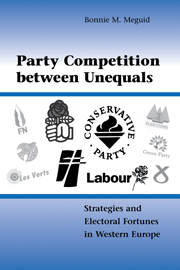Book contents
- Frontmatter
- Contents
- List of Tables and Figures
- List of Abbreviations and Acronyms
- Acknowledgments
- 1 THE NICHE PARTY PHENOMENON
- 2 POSITION, SALIENCE, AND OWNERSHIP: A STRATEGIC THEORY OF NICHE PARTY SUCCESS
- 3 AN ANALYSIS OF NICHE PARTY FORTUNES IN WESTERN EUROPE
- 4 A THEORY OF STRATEGIC CHOICE
- 5 STEALING THE ENVIRONMENTAL TITLE: BRITISH MAINSTREAM PARTY STRATEGIES AND THE CONTAINMENT OF THE GREEN PARTY
- 6 “THE ENEMY OF MY ENEMY IS MY FRIEND”: FRENCH MAINSTREAM PARTY STRATEGIES AND THE SUCCESS OF THE FRENCH FRONT NATIONAL
- 7 AN UNEQUAL BATTLE OF OPPOSING FORCES: MAINSTREAM PARTY STRATEGIES AND THE SUCCESS OF THE SCOTTISH NATIONAL PARTY
- 8 CROSS-NATIONAL COMPARISONS AND EXTENSIONS
- 9 CONCLUSIONS: BROADER LESSONS OF COMPETITION BETWEEN UNEQUALS
- References
- Index
- Cambridge Studies in Comparative Politics
4 - A THEORY OF STRATEGIC CHOICE
Published online by Cambridge University Press: 25 July 2009
- Frontmatter
- Contents
- List of Tables and Figures
- List of Abbreviations and Acronyms
- Acknowledgments
- 1 THE NICHE PARTY PHENOMENON
- 2 POSITION, SALIENCE, AND OWNERSHIP: A STRATEGIC THEORY OF NICHE PARTY SUCCESS
- 3 AN ANALYSIS OF NICHE PARTY FORTUNES IN WESTERN EUROPE
- 4 A THEORY OF STRATEGIC CHOICE
- 5 STEALING THE ENVIRONMENTAL TITLE: BRITISH MAINSTREAM PARTY STRATEGIES AND THE CONTAINMENT OF THE GREEN PARTY
- 6 “THE ENEMY OF MY ENEMY IS MY FRIEND”: FRENCH MAINSTREAM PARTY STRATEGIES AND THE SUCCESS OF THE FRENCH FRONT NATIONAL
- 7 AN UNEQUAL BATTLE OF OPPOSING FORCES: MAINSTREAM PARTY STRATEGIES AND THE SUCCESS OF THE SCOTTISH NATIONAL PARTY
- 8 CROSS-NATIONAL COMPARISONS AND EXTENSIONS
- 9 CONCLUSIONS: BROADER LESSONS OF COMPETITION BETWEEN UNEQUALS
- References
- Index
- Cambridge Studies in Comparative Politics
Summary
In 1970, calling for the protection of “our British Native stock” against “colored immigration,” the National Front fielded candidates in its first parliamentary election. Formed four years earlier by a merger of the League of Empire Loyalists and the British National Party, the National Front criticized the absence of the immigration issue from mainstream party political debate. Over the next decade, this xenophobic niche party would try to force the issue onto the political agenda with its repeated calls for the immediate cessation of immigration to the United Kingdom and repatriation of all nonwhite foreigners.
Although it garnered an average vote of less than 4 percent across contested districts, or a scant 0.3 percent average nationwide during the 1970s, the National Front did not go unnoticed by the British mainstream parties. The Conservative Party reacted with intense accommodative tactics to the defection of some of its voters to the niche party. Adopted by the Heath government as early as 1973, the Tories' accommodative proposals included the strengthening of immigration controls and the retraction of British citizenship obligations to immigrants from former Commonwealth nations. Conservative politicians, including party leader and future Prime Minister Margaret Thatcher, even invoked the National Front's xenophobic imagery of Britain as “a crowded island” being “swamped” by foreigners to try to win (back) anti-immigrant voters.
- Type
- Chapter
- Information
- Party Competition between UnequalsStrategies and Electoral Fortunes in Western Europe, pp. 91 - 109Publisher: Cambridge University PressPrint publication year: 2008



